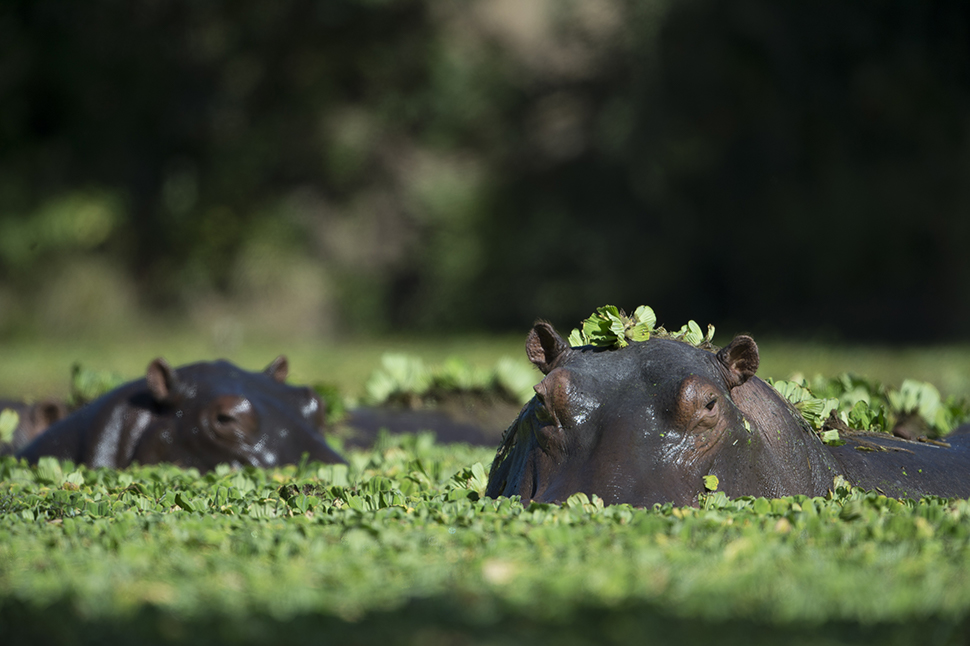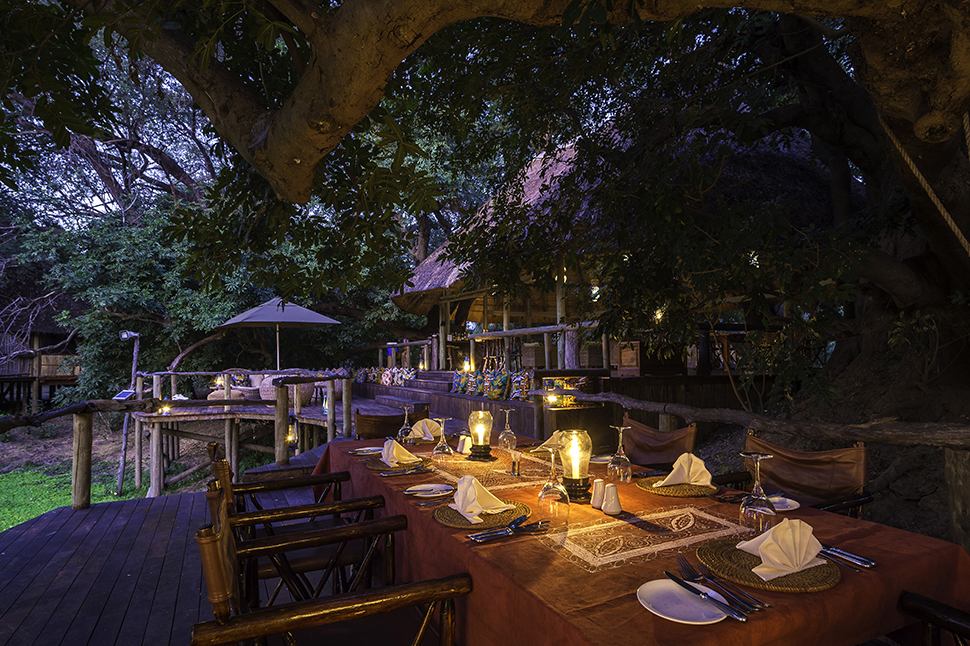

An African safari is an incredible way to connect with nature and disconnect from everything else. Safaris are most often taken by jeep, but in Zambia’s South Luangwa National Park, The Bushcamp Company leads walking safaris, a unique experience that brings you closer to the animals that call this place home.
Getting there
South African Airways flies several times daily to Zambia’s capital, Lusaka, via Johannesburg. ProFlight Zambia flies between Lusaka and Mfuwe Airport two to three times daily. From there, it’s a 40-minute drive to The Bushcamp Company’s Mfuwe Lodge or up to a two-hour ride to the bushcamps.
The company also can arrange a charter flight to Kapamba Airstrip, about a 30-minute drive from the bushcamps.

What to pack for a walking safari
On a jeep safari, you can don any footwear, even flip-flops, though closed-toe options are best. For a walking safari, however, you’ll want to pack comfortable shoes with thick soles, like sneakers.
Avoid wearing black and navy blue, which attract tsetse flies, whose bites are very itchy. Khaki, olive green, light green and gray are best.
Head covering is crucial. A baseball cap will do, but a wide-brimmed hat is better. Make sure it has a chin strap or you’ll lose it to the wind.
Sunscreen, bug spray and a reusable water bottle are musts. All properties have water coolers where you can fill up.

The experience
South Luangwa National Park has everything but rhinos (sadly poached to extinction). On morning and afternoon game drives, you are likely to see elephants aplenty, lions, Cape buffalo, hyenas, African wild dogs, zebras, Thornicroft’s giraffe (found only in South Luangwa), a few dozen birds (there are more than 400 varieties) and leopards (the park has one of the continent’s densest concentrations).
Safari is a thrilling adventure, but it’s generally not very active. Early mornings and late afternoons are spent sitting on game drives, between which there’s ample time for a snooze, reading or languidly watching elephants come to the river. When you’re in the jeep, you’re several feet off the ground and buffered slightly from the bush by its frame. On a walking safari, there is nothing between you and nature. It’s a chance to roam through the wild as animals do.
For Forbes Travel Guide’s walking safari, we planned to trot around four miles between two elegant but homey bushcamps, departing from Bilimungwe and ending at Chindeni. At breakfast, watching the sun rise over the river, we were eager for the journey: we were going to walk through the Zambian bush, deep in the heart of a 3,500-square-mile national park, and we couldn’t help but wonder what we’d find upon arriving there.

Before we left camp, our lead guide, Fannuel Banda, who’s been with Bushcamp Company since 2005, gave us a safety briefing. He told us to walk in single file, with our ranger always at the front and one of Bushcamp’s guides at the back. Banda soothed any nerves by reminding us that animals in the bush were not interested in humans and would not approach us. After two days of game drives, we knew this was true; animals wouldn’t even approach the jeep.
After breakfast, we set out along the bank of the Luangwa River, the better to stay in the shade. Leading the charge was Edgar, a ranger from the Department of National Parks and Wildlife carrying a rifle. Most of the rangers have served in the military, and Edgar told us that in 17 years of doing these excursions, he’s never had to use his weapon.
Right behind him was Banda, followed by our group of five, including Bushcamp Company’s resident yoga instructor. Bringing up the rear was another smart and sunny guide, Jacob. These men grew up in the areas surrounding South Luangwa National Park and knew it extremely well. Safety is paramount to them, and we knew they would do everything possible to keep us secure. This, in turn, made us feel completely safe walking through the bush.
Banda, indefatigable and brimming with knowledge, loves walking safaris. “You can smell the jasmine,” the 39-year-old said. “You can feel the ground. You get to look up close at footprints, the tracks, where a leopard has just walked. You can hear the leopard calling in the distance. And you are walking in its footsteps.”
Five minutes into our walk, Banda became excited, pointing down to a leopard print the size of a baseball. “Look at this,” he said. “You can see how fresh this print is. Brilliant! We’re on the right track.”
We continued along, eyes scanning the wheat-colored terrain for any sign of movement. A few feet above, a lilac-breasted roller sat regally in an acacia tree, its beautiful violet and teal feathers forming a Technicolor dreamcoat. For a minute we’re still, gaping at this tiny, vivid bird, so vibrant against the otherwise pale yellow-brown landscape — it’s winter, and dry season.
Up in the jeep on earlier rides, the savannah’s grass appeared just a foot tall, but now we’re walking through waist- and even chest-high stalks just like the animals we’re following. Ahead, Fannuel spotted the top half of a Cape buffalo skull, its horns smooth and beige. He explained that buffalo are herbivores, so when it dies, it feeds predators and then slowly decomposes, returning to the earth from which it grazed.
On an evening game drive the previous day, we’d seen a herd of more than 100 buffalo with shiny coats. Banda said that buffalos are experts in self-defense, fending off lions and leopards.

The next skull we saw was that of a hippo. Banda lifted the upper jaw to show us the hippopotamus’ enormous foot-long incisors and its 16 bottom teeth. We observed and heard dozens of hippos over the last couple of days and, as with the buffalo, it was striking to see its skull just sitting in a field surrounded by the vast expanse of the park.
After walking for an hour and a half, we entered a clearing shaded by several sausage trees. Banda pointed to a huge fallen branch wide enough to sit on and joked, “Here is your bush throne!”
From his rucksack, Jacob pulled out full tea and coffee service, which he set on a pretty place mat with a circular pattern. We passed around a tin of The Bushcamp Company’s homemade cookies — not too sweet and great for dunking. As we sat stretching our legs, Banda told us that the sausage fruit’s pulp is a natural anti-itch balm for bug bites. He handed a fallen one around and we’re surprised by its heft; it weighed a good 15 pounds. Banda sliced it open and we took it in turns slathering it on our bites. Within minutes, the itching stopped.
He then started teasing us, asking how far we think we are from Chindeni, our bushcamp for the next two nights. Banda joked that we’ve got another hour and a half to go.
With the Cape turtle dove crowing, we set off again, pausing to look at more leopard footprints. “What’s the difference between a leopard and a cheetah?” we asked sheepishly. Banda, a born educator, said, “Good question!” He then told us that leopards are heavier and stockier where cheetahs are slender. Cheetahs also have single, evenly spaced spots while leopards’ black spots form a rosette.
Pointing to the leopard’s paw print, which has no claw marks, Banda added that leopards have retractable claws, which they use for climbing trees, fighting or grabbing prey. Cheetahs, on the other hand, need good traction as they fly through the grass, so their claws never move.

After less than 20 minutes, we spied a thatched roof, signaling our arrival at Chindeni Bushcamp. We dug into the brunch set out on the communal dining table, piling our plates with quiche, salad and roasted beets.
In the end, we didn’t see many animals on our walking safari, but that didn’t matter. It had been bliss to walk through nature, with no phone reception or emails, no noise other than light birdsong and the wind rustling leaves and the tall grass. Though the group chatted amicably the whole time, the walk was meditative, and we communed more deeply with the bush than we had in the car.
The next afternoon, we saw a pod of hippos cooling off in the river. Then Banda noticed vultures flying overhead, signaling a kill nearby. He expertly piloted the Land Rover Defender through thick brush and there, in a clearing, were several lions flopped on the ground in pantomime of an afternoon siesta. They were guarding an enormous dead hippo from vultures. Looking through binoculars, Banda could see the hippo was unscathed and told us it probably died naturally, a real boon for the lions.
Then we thought back to the hippo skull on the walk and feeling its long, sharp incisors and wide, flat molars. We had seen life and death on our safari, the true circle here in the Zambian bush.
